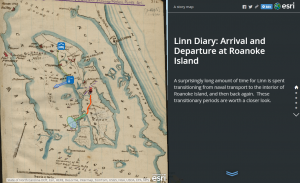Humans often think in terms of space: where things are, how far apart, in what direction. When examining a story, whether it be real or fictional, mapping out a spatial representation of the events can be a powerful tool in understanding deeper meanings and reasons. As Bodenhammer explains it, “space offers a way to understand fundamentally how we order our world” (14).
Many of the decisions we make every day are greatly dependent on how we examine the space around us. This was no different for people living 100 or 1000 years ago. When we look at historical recordings, the reasoning behind many actions can be lost or go unseen, simply because we can’t see what they saw. However, using GIS mapping, historical maps, and other visual tools, we can recreate, to some extent, the world that these historical figures lived in. By examining these maps and other visuals, we gain a better understanding of the circumstances and influences that led people to decide on the actions they took. Bodenhammer mentions the example of the discovery of the New World (14-15). It’s hard for us to imagine the allure of this land to the European countries 500 years ago because we know this place as our home. However, historical maps and paths of the journeys of explorers let us see the vast open expanse that existed here. Combine that with maps of population growth and religious turmoil in Spain, France, and England, and we can start to see the circumstances that led to the era of colonization.
Working in this way with Linn’s diary led to many interesting revelations. The GIS mapping I did of his arrival to and departure from Roanoke island revealed a number of things about his experiences. For instance, in his diary entry on February 7th, he mentions having to walk through a swamp to reach the rest of the regiment after making shore on the island. With Linn’s short description, it was impossible to determine just how long he spent traversing these wetlands. However, by drawing the path between the landing point and the regiment using GIS, I was able to see that most of that 2 mile journey was through swamp. Once arriving at camp, Linn seems in a rather negative mood. The difficulty that this march must have presented would explain his feelings at the time.
Bodenhammer describes a potential use of GIS technology as creating a myriad of different layers on a map, where each one “would contain the unique view over time – the dynamic memory – of an individual or a social unit” (27-28). I think it would be very interesting to see what we could make of journal entries of different people with connections to Linn. The personal stories of Beaver or General Reno could provide us with more insight into the things Linn didn’t write down, how these people were connected, and where their paths crossed and diverged.
